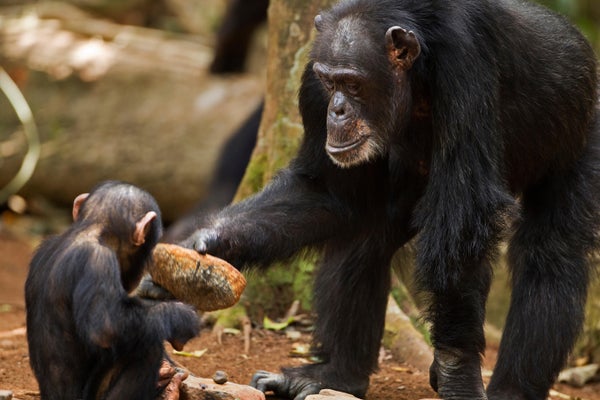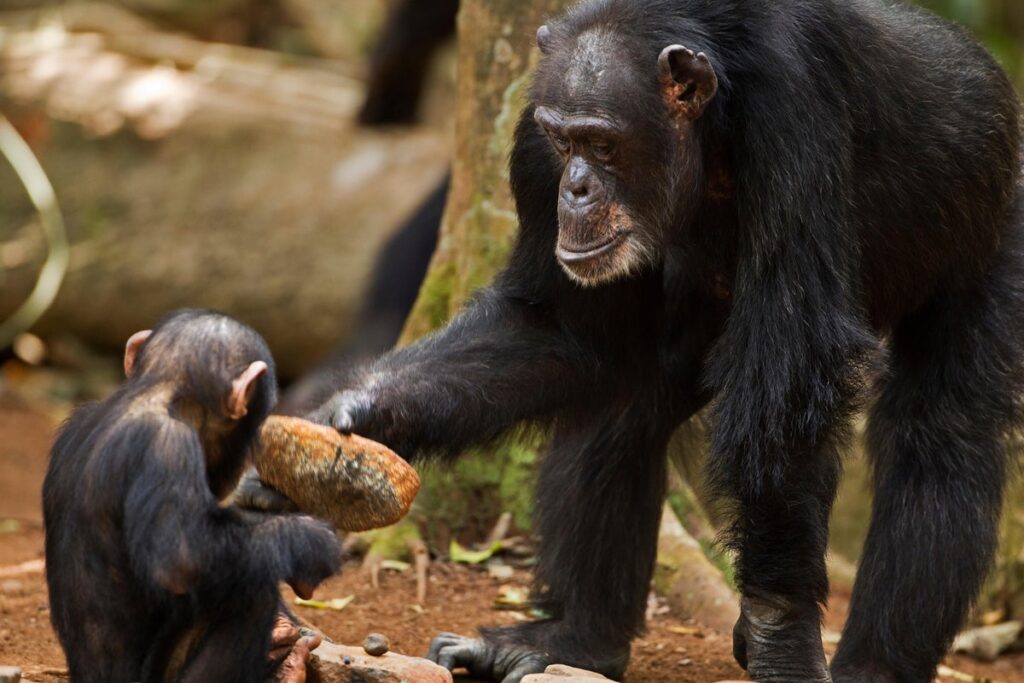[ad_1]
November 21, 2024
3 min read
Chimps Share Knowledge like Humans Do, Spurring Innovation
Female chimps who migrate to new social groups bring skills and technology with them, helping to drive development of increasingly complex tool sets

Western chimpazee female “Fana” aged 54 years shows her grandson ‘Flanle’ aged 3 years how to crack open palm oil nuts in Bossou Forest, Mont Nimba, Guinea.
Nature Picture Library/Alamy Stock Photo
Chimpanzees live in fiercely hierarchical social communities whose male members remain within the same group over time. To prevent inbreeding, females migrate to new communities when they reach adulthood. They bring with them not only new genes but also new knowledge.
As this process repeated itself across thousands of years, female chimpanzees played an integral role in driving cultural innovation, a new study reports. Females spread behaviors between communities, and those behaviors were recombined with existing traditions to create layers of innovation that resulted in increasingly complex and advanced tool sets.
The new research shows that humans are not the only species capable of building on innovations over time to make them more efficient, says Cassandra Gunasekaram, a doctoral student in evolutionary biology at the University of Zurich and lead author of the study, which was published in Science. Additionally, she says, the research demonstrates “the importance of social links between different populations of chimpanzees for driving the complexity of culture.”
On supporting science journalism
If you’re enjoying this article, consider supporting our award-winning journalism by subscribing. By purchasing a subscription you are helping to ensure the future of impactful stories about the discoveries and ideas shaping our world today.
As recently as the 1990s, the idea that nonhuman animals could exhibit the distinct, socially learned behaviors that constitute culture was controversial. Numerous examples of animal culture are now known, including a diversity of bird song dialects, whale vocalizations and honeybee “waggle dance” moves.
The new chimpanzee paper shows an example of cumulative culture, however, which is different. Cumulative culture refers to knowledge that is transmitted from generation to generation, enabling the development of increasingly sophisticated new technologies that result from gradual accumulation of new ideas and breakthroughs, contributed by multiple minds. The products of cumulative culture are usually so complex that it would be virtually impossible for a single individual to invent them. Computers are an example: they have gained in complexity and efficiency as researchers have iterated and built on what came before to the point that no person could create one with today’s standards completely from scratch.
Cumulative culture is still primarily considered to be a feature of human society. Some researchers have begun to question that assumption, however, and this latest research supports that cumulative culture might be found in some other species. Like humans, chimpanzees seem to have the capacity to exchange and combine ideas, says the study’s co-senior author Andrea Migliano, an evolutionary anthropologist at the University of Zurich. She adds, however, that the amount of cultural knowledge that the animals can accumulate is limited by their hierarchical social structures, restricted migration among groups and lack of spoken language.
To perform the new study, Migliano, Gunasekaram and their colleagues turned to a preexisting open dataset maintained by the Pan-African Program, a chimpanzee research consortium. They used genetic data from 240 individual chimpanzees from 35 different communities, representing all four subspecies, to trace past encounters among the animals. First, the researchers reconstructed 5,000 years of ancestry by analyzing segments of DNA that indicated common relatives and got broken into smaller pieces across generations. Next, they traced population links back 15,000 years by tracking genetic variants that occurred in individual groups but were rare in others.
In addition to the genetic analyses, they also built a map of 15 foraging behaviors across chimpanzee populations. They divided the behaviors into three categories: the simplest behaviors involved no tools; intermediate examples relied on a single tool; and the most complex ones depended on a sophisticated tool set. An example of a complex tool set comprised a multistep approach to accessing beehives inside trees by using different tools for pounding open a hive, breaking into its inner chamber and swabbing up the honey for collection.
Finally, the researchers overlaid and compared these networks of acquired data—genetic relatedness and cultural similarities—to see whether one predicted the other, providing possible confirmation for cumulative culture. When the simplest behaviors were included, they found no corresponding evidence of genetic exchanges between groups. When only the most complex behaviors were analyzed, however, they found a clear correlation with female migrations. This suggests that females moving to a new group play a role in driving innovation and fits the hypothesis that social transmission between groups is necessary for the development of only the most sophisticated tools, not the simpler ones, Migliano says. “The big pattern we’re seeing is: if it’s complex, it’s really correlating with migration and is unlikely to be reinvented,” she adds.
“This project provides the best evidence yet that wild chimp traditions really are cultural and that they can, and have, evolved cumulatively,” says Thomas Morgan, an evolutionary anthropologist at Arizona State University, who was not involved in the work. “The past few decades have seen the emergence of the idea that cumulative cultural change is our species’ secret incredeint, but recent work, including this project, is really changing that view.”
[ad_2]
Source link

